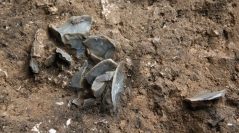

 Comptes Rendus Palevol
16 (8) - Pages 865-877
Comptes Rendus Palevol
16 (8) - Pages 865-877Lithic refitting studies have consistently contributed to address two specific research aims: the intra-site mobility and identification of preferential areas or latent structures, and the in-depth analysis of the knapping technologies and core reduction strategies. Multiple refits, in particular, can produce highly detailed data on knapped stone technology. Elucidating human skills and lithic economy, a potential still rarely evaluated for Discoid technology: a stone knapping method largely spread across the Middle Paleolithic of Europe. The opportunity to explore Neanderthal knapping behavior is provided from the remarkable discovery of a primary lithic waste concentration in the Mousterian Discoid level of the Grotta di Fumane, Italy, dated to at least 47.6 ky cal BP. With a combined approach that included the 3D virtual interaction, we were able to reproduce a complete reduction sequence that supports the technological analysis conducted on the lithic assemblage. Results lead to a better comprehension of the knapper's technological and technical behavior, including the detection and quantification of economic objectives and productivity.
Knapped stone, 3D visual technology, Refitting, Discoid technology, Neanderthal, Middle Paleolithic